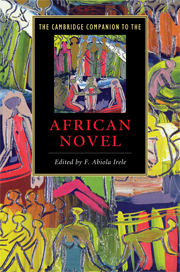Book contents
- Frontmatter
- 1 Introduction: perspectives on the African novel
- 2 The oral-literate interface
- 3 Chinua Achebe and the African novel
- 4 Protest and resistance
- 5 The Afrikaans novel
- 6 The African novel in Arabic
- 7 The francophone novel in North Africa
- 8 The francophone novel in sub-Saharan Africa
- 9 The African historical novel
- 10 Magical realism and the African novel
- 11 The African novel and the feminine condition
- 12 Autobiography and Bildungsroman in African literature
- 13 The postcolonial condition
- 14 New voices, emerging themes
- 15 The critical reception of the African novel
- Bibliography
- Index
11 - The African novel and the feminine condition
Published online by Cambridge University Press: 28 January 2010
- Frontmatter
- 1 Introduction: perspectives on the African novel
- 2 The oral-literate interface
- 3 Chinua Achebe and the African novel
- 4 Protest and resistance
- 5 The Afrikaans novel
- 6 The African novel in Arabic
- 7 The francophone novel in North Africa
- 8 The francophone novel in sub-Saharan Africa
- 9 The African historical novel
- 10 Magical realism and the African novel
- 11 The African novel and the feminine condition
- 12 Autobiography and Bildungsroman in African literature
- 13 The postcolonial condition
- 14 New voices, emerging themes
- 15 The critical reception of the African novel
- Bibliography
- Index
Summary
We must define the feminine condition beyond a biologically given feminine essence and a homogenous female experience. Women’s lives within cultures are shaped not only by their biology but also by the material and social conditions of their societies, by their individual locations within communities and by the forms of power embedded in particular cultural norms. Our notion of the feminine should in addition encompass all those yearnings and desires of women that are never specifically named because communities do not acknowledge them in their understanding of the feminine. How all these situations are experienced, resisted and transformed through time should also be part of our conception of the feminine condition. To explore the feminine condition in the African novel is to examine how these wider ramifications of women’s lives are mapped, interrogated and reinvented in the medium of the novel. The novel’s capacity to map and reorganize reality has made it the most convenient medium for African writers seeking to rethink their social worlds in transitional and postcolonial times. As a genre that encourages interiority and accommodates other genres, forms, and voices, the novel opens individual locations of struggle and desire and provides a flexible and discursive space for relating to the collective in new ways. While the feminine theme may be seen as part of this general reinvention of African worlds, it has been represented in the African novel through varying perspectives and ideologies and must be explored within an interpretive framework that can unravel both the discourse of the feminine and the politics of its representation.
- Type
- Chapter
- Information
- The Cambridge Companion to the African Novel , pp. 177 - 194Publisher: Cambridge University PressPrint publication year: 2009
- 1
- Cited by



